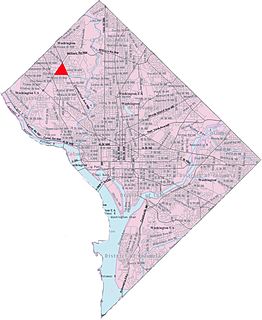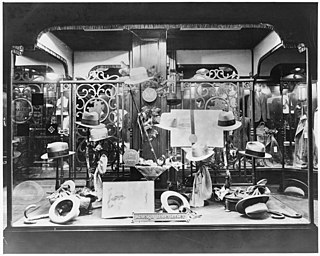Related Research Articles

Adams Morgan is a neighborhood in Northwest Washington, D.C., centered at the intersection of 18th Street NW and Columbia Road, about 1.5 miles (2.54 km) north of the White House. Notable establishments in the neighborhood include the Washington Hilton and Madam's Organ Blues Bar. Notable residential buildings include Euclid Apartments, Fuller House, Park Tower, Meridian Mansions, and the Pink Palace. Embassies in the neighborhood include the Embassy of Lithuania, the Embassy of Poland, the Embassy of the Central African Republic, the Embassy of Gabon and the Embassy of Cuba. Notable public artwork in Adams Morgan includes Carry the Rainbow on Your Shoulders, The Servant Christ, and The Mama Ayesha's Restaurant Presidential Mural.

Mount Pleasant is a neighborhood in the northwestern quadrant of Washington, D.C. It is bounded by Rock Creek Park to the north and west; Harvard Street NW to the south; and 16th Street NW to the east. It is north of Adams Morgan and west of Columbia Heights. It is home to approximately 10,000 people.

Shepherd Park is a neighborhood in the northwest quadrant of Washington, D.C. In the years following World War II, restrictive covenants which had prevented Jews and African Americans from purchasing homes in the neighborhood were no longer enforced, and the neighborhood became largely Jewish and African American. Over the past 40 years, the Jewish population of the neighborhood has declined, but the neighborhood has continued to support a thriving upper and middle class African American community. The Shepherd Park Citizens Association and Neighbors Inc. led efforts to stem white flight from the neighborhood in the 1960s and 1970s, and it has remained a continuously integrated neighborhood, with very active and inclusive civic groups.
Hecht's, also known as Hecht Brothers, Hecht Bros. and the Hecht Company, was a large chain of department stores that operated mainly in the mid-Atlantic and southern region of the United States. The firm originated in Baltimore, Maryland.

Mount Vernon Square is a city square and neighborhood in the Northwest quadrant of Washington, D.C. The square is located where the following streets would otherwise intersect: Massachusetts Avenue NW, New York Avenue NW, K Street NW, and 8th Street NW.
Woodward & Lothrop was a department store chain headquartered in Washington, D.C. that began as the capital's first department store in 1887. Woodies, as it was often nicknamed, maintained stores in the Mid-Atlantic United States. Its flagship store was a fixture of Washington, D.C.'s downtown shopping district, competing with Garfinckel's and acquiring Palais Royal. The chain filed for bankruptcy in January 1994 and completed liquidation in November 1995, with most locations sold to either J. C. Penney or May Department Stores Company. The flagship building is a D.C. historic landmark that would become the center of controversy over competing visions for DC's urban renewal after the chain's demise, and the former service warehouse in the city's northeast is also listed as a landmark.

Streetcars in Washington, D.C. transported people across the city and region from 1862 until 1962.

Harry Wardman was a real estate developer in Washington, D.C. during the early 20th century whose developments included landmark hotels, luxury apartment buildings, and many rowhouses. When he died in 1938, one-tenth of the residents of Washington were said to live in a Wardman-built home.
The Mount Vernon Seminary and College was a private women's college in Washington, D.C. It was purchased by George Washington University in 1999, and is now known as the Mount Vernon Campus of The George Washington University.

Garfinckel's was a prominent department store chain based in Washington, D.C. that catered to a clientele of wealthy consumers. Its flagship store at 14th and F in the city's F Street shopping district is listed on the National Register. It filed for Chapter 11 bankruptcy in June 1990 and ceased operations that year.
Best & Co. was a department store founded in 1879 by Albert Best in New York City. The company initially sold clothing for infants and children, but later expanded to women's clothing and accessories. It was known for its "tastefully styled and proper women's clothes and its sturdy children's wear." Philip Le Boutillier served as president during the late 1930s. The store had expanded to 20 branches by 1966, when the company was acquired by McCrory's, who also operated Lerner Shops and S. Klein. In late-1970, McCrory's liquidated the company. At the time of its closing, the store had 1,200 employees.

Wakefield is a neighborhood in the Northwest quadrant of Washington, D.C., bounded by Albemarle Street NW to the south, Nebraska Avenue NW to the west, and Connecticut Avenue to the east. It is served by the Van Ness-UDC and Tenleytown-AU station on the Washington Metro's Red Line.

Raleigh Haberdasher, more commonly called Raleigh's, was a high end, local men's and women's furnishings store based in Washington, D.C.
The Marlow Heights Shopping Center is an open-air shopping complex located in Marlow Heights, Maryland, on Branch Avenue at St. Barnabas Road, and is positioned just south of Shops at Iverson.
Lansburgh's was a chain of department stores located in the Washington, D.C. area. The clientele were middle-income consumers.
The Frank R. Jelleff Co., or more commonly Jelleff's was a Washington, D.C.-based retailer that specialized in women's apparel.

District Grocery Stores (DGS) was a cooperative of small single-room grocery stores in Washington, DC, Maryland and Northern Virginia. It operated from 1921 to 1972. The goal was to leverage the volume of purchasing power of the cooperative to negotiate better prices from wholesalers and therefore improve their competitiveness. The cooperative started with 20 members and grew to 300 members at its peak, most of whom were Jewish immigrant families from Europe. The stores were located across the Washington metropolitan area.

Swelldom was a large women's clothing store variously described as a "cloak and suit house" and a "department store", operating from 1906 until the 1970s in California. It had locations on Broadway in Downtown Los Angeles' shopping district, later on Wilshire Blvd. at Camden in Beverly Hills, and near Union Square in San Francisco.

The Demonet Building is composed of a historic townhouse and adjoining office building on the southeast corner of Connecticut Avenue and M Street NW in Washington, D.C. Constructed in 1880, the townhouse is the last Victorian residence on Connecticut Avenue between Dupont Circle and Farragut Square that has not been significantly altered. It features an octagonal tower topped by a dome with cartouche windows. Following a multi-year legal battle to demolish the townhouse, which had been added to the District of Columbia Inventory of Historic Sites in 1979, the Demonet Building and adjoining lot were sold for what was then a record price for downtown real estate. The adjoining office building, designed by Skidmore, Owings & Merrill, was completed in 1984.

The Old Korean Legation Museum is a historic house museum located at 15 Logan Circle NW in the Logan Circle neighborhood of Washington, D.C. Built in 1877 as a residence for military officer and politician Seth Ledyard Phelps, the house served as the legation for the Joseon kingdom followed by the Korean Empire from 1889 to 1905 when Japan took control of Korea's government. The building was sold in 1910 for $10 and later served as a recreation center for African Americans, trade union hall, and private residence.
References
- ↑ Display ad, 'The Washington Post', October 13, 1907, p. E7.
- ↑ Obituary of Mrs. David Frank, The Washington Post and Times-Herald , February 23, 1962, pg. B3.
- ↑ "Decorative New Shops Open Today", The Washington Post. September 7, 1949, pg. B5.
- ↑ Display ad, The Washington Post, January 25, 1953, pg. S7.
- ↑ "Erlebacher's Keeps Old Name in Purchase", by William H. Jones, The Washington Post and Times-Herald, September 23, 1972, pg. D8.
- ↑ "Erlebacher's Closing May Be Short-Lived", by Claudia Levy, The Washington Post, June 6, 1974, pg. E1.